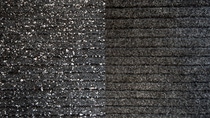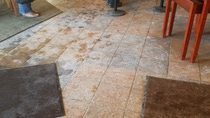Media
Second line of defense—keeping floors tracking-free during winter months

As wintertime rolls around, most focus on deicing streets and driveways of their properties outside—and less on chloride-salt tracking that follows pedestrians inside the buildings. This outdoor deicing is what some would call the first line of defense.
While traditional, granular-ice-melt solutions may be helpful in melting snow farther from the property—the closer you get to the building and track residue inside—the messier and more damaging the chloride salts become to your floors and property indoors.
Ice-melt chemistry
Chloride-based ice-melt solutions are generally hygroscopic—they attract moisture from the atmosphere. The chemical property causes the granular particles to dissolve as it would in the ice-melting process outdoors. Indoors, however, these materials create a damp puddle on the floors if not cleaned up effectively and consistently throughout the storm period. The chemical reaction of chloride ice-melting solutions mixed with mildly alkaline all-purpose floor cleaners or carpet cleaners creates a cloudy solution that inevitably leaves streak marks or white crystalline residue on carpets and matting, no matter how many times you clean the floor.
Furthermore, popular chloride melts not only scratch the floor and corrode metals, they get inside vacuums, damaging them. The chlorides that makes up these deicers also pose health risks for pet paws, the surrounding flora and water streams. Additionally, once melted, the indoor tracking residue poses risks to human safety, creating opportunities for slip-and-fall accidents.
Building managers who have caught on to the dichotomy of chloride-salt deicers serving two different purposes for the outdoors and the indoors, have invested thousands of dollars and man hours on internal building maintenance—having someone stand by with a mop and bucket cleaning up indoor tracking of chloride-salt deicers at the same time as another person throws the salt outdoors.


Big expense
The cost of special cleaning at entranceways during storms is around $50-$60 per entranceway. This includes labor, cleaning, equipment and tools, according to Mark Warner, Cleaning Management Institute Education Manager for the International Sanitary Supply Association (ISSA).
“With two to three entranceways and two to three cleanings per day during a storm, the added cost of added cleaning could easily exceed $400-$500 per day, per building,” said Warner. “When you consider a college campus or a corporate plaza, it is easy to see why anything that reduces this cost more than offsets any nominal increase in the cost of material would (actually) reduce or eliminate spending.”
The solution/second line of defense
Warner has been in cleaning management for 30 years and works for a non-profit. Therefore, he does not endorse any commercial brand. He does admit—when asked—however, that he’s heard of a product that could remedy these pain points while keeping both the inside and the outside of the building safe.
This second line of defense is called Entry. What makes this deicer unique from all others is that it is in liquid form and chloride-free. Its chemistry includes formate salts, a more natural product that’s less corrosive on floors, metals and friendlier on pet paws and the environment. Using BASF’s formic acid, which was transformed into a potassium formate liquid, customer Branch Creek created a biodegradable solution for both commercial and residential deicing, which is urea-free and works immediately. Unlike traditional ice-melt solutions, Entry does not possess any harmful residue and since it has no visible tracking, it eliminates the mess of chloride salts.
“To a lot of people, the cleanliness of the floor helps them determine what they think of the cleanliness of the building and the people inside the building,” said Nate Clemmer, CEO & Founder of Branch Creek. “Entry has a very similar pH to water, so it looks like water on the floor and dries like water. So being a neutral pH, it’s just a softer chemistry that’s used on flooring surfaces.”
In fact, the chloride-free deicer has recently won an ISSA - The Worldwide Cleaning Industry Association Innovation of the Year Award, which is no small feat.
While old habits die hard, and no one expects building managers and residents alike to drop granular salts all together, Warner believes there’s a silver lining—being able to use both, just in different distances from the entranceways. As a cleaning-management guru who trains other supervisors, Warner suggests building managers use the chloride salts farther from the entrance, in the parking lots and on the perimeter of sidewalks. But when they get within 50 feet of the building—a liquid chloride-free deicer is the way to go.
“Put it 50 feet out. Don’t throw any granular material closer to the entrance. It’ll tramp all of the granules off as they walk into the building and what comes into the building won’t harm it,” said Warner. “It’ll also create labor savings. Ultimately, this would be a way of increasing the appearance of the building, the safety of the building, while at the same time reducing cost.”
Green pioneer
Aside from being less harmful to pedestrians and to your floors, Entry liquid ice-melt is also a pioneer green product. It is the first ever ice-melt solution to be Green Seal certified—meeting “a rigorous standard for transformative product innovation with a deicer that is safer for people and the planet while performing more effectively than market competitors,” according to greenseal.org.
Going green is something that is very important to Warner, as a cleaning management expert for the past three decades. But what green means to him is very different than what it may mean to other people.
“The friendliness to the environment goes without saying. But what green means to me is human and health safety,” Warner concluded. “That trumps all. When we talk about human health safety, it’s the use of products that are nontoxic and don’t hurt human beings.”
Published by Anna Spiewak.
For media inquiries or to repurpose this article, please contact Lisa Brown.